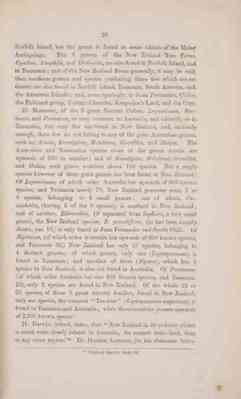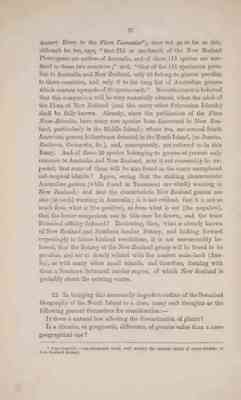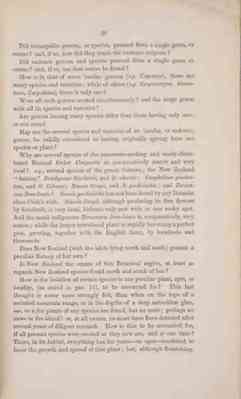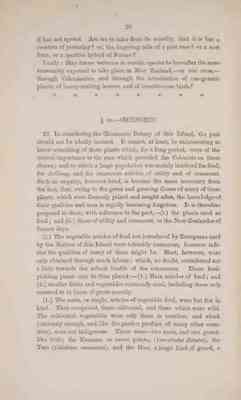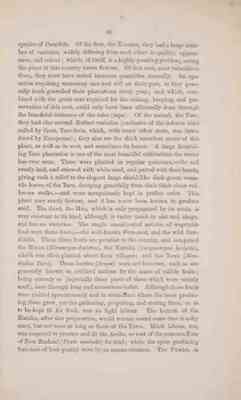Pages
26 Norfolk Island, but the genus is found in some islands of the Malay Archipelago. The 3 genera of the New Zealand Tree Ferns, Cyathea, Alsophila, and Dicksonia, are also found in Norfolk Island, and in Tasmania; and of the New Zealand Ferns generally, it may be said, their southern genera and species (excluding those few which are endemic) are also found in Norfolk Island, Tasmania, South America, and, the Antarctic Islands; and, more sparingly, in Juan Fernandez, Chiloe, The Falkland group, Tristan d'Acunha, Kerguelen's Land, and the Cape.
20. Moreover, of the 3 great Natural Orders, leguminosae, Myrtaceae, and Proteaceae, so very common in Australia, and tolerably so in Tasmania, but very few are found in New Zealand, and curiously enough, these few do not belong to any of the great Australian genera, such as, Acacia, Eucalyptus, Melaleuca, Grevillea, and Hakea. The Australian and Tasmanian species alone of the genus Acacia are upwards of 260 in number; and of Eucalyptus, Melaleuca, Grevillea, and Hakea, each genus numbers above 100 species. Not a single species however of those great genera has been found in New Zealand! Of Leguminosae, of which order Australia has upwards of 900 known species, and Tasmania nearly 70, New Zealand possesses some 7 or 8 species, belonging to 3 small genera; one of which, Carmichaelia, (having 5 of the 8 species), is confined to New Zealand; and of another, Edwardsia, (if separated from Sophora, a very small genus), the New Zealand species, E. grandiflora, (as has been already shown, par. 19,) is only found in Juan Fernandez and South Chili. Of Myrtaceae, (of which order Australia has upwards of 650 known species, and Tasmania 36,) New Zealand has only 15 species, belonging to 4 distinct genera; of which genera, only one (Leptospermum) is found in Tasmania; and another of them (Myrtus), which has 4 species in New Zealand, is also not found in Australia. Of Proteaceae, (of which order Australia has also 650 known species, and Tasmania 22), only 2 species are found in New Zealand. Of the whole 24 or 25 species, of those 3 great natural families, found in New Zealand, only one species, the common "Tea-tree" (Leptospermum scoparium) is found in Tasmania and Australia; while those countries possess upwards of 2,200 known species!
21. Darwin, indeed, states, that "New Zealand in its endemic plants is much more closely related to Australia, the nearest main-land, than to any other region."* Dr Hooker, however, (in his elaborate Intro___________________________________________________________ * Origin of Species, chap. xii.
27 ductory Essay to the Flora Tasmanieae*), does not go so far as this, although he, too, says, "that 216 or one-fourth of the New Zealand Phaenogams are natives of Australia, and of these 115 species are confined to these two countries;" and, "that of the 115 specimens peculiar to Australia and New Zealand, only 26 belong to genera peculiar to those countries, and only 6 to the long list of Australian genera which contain upwards of 20 species each." Nevertheless it is believed that this comparison will be very materially altered, when the whole of the Flora of New Zeland (and the many other Polynesian Islands) shall be fully known. Already, since the publication of the Flora Novae-Zelandiae, have many new species been discovered in New Zealand, particularly in the Middle Island; where too, are several South American genera hitherto not detected in the North Island, (as Donatia, Rostkovia, Gaimardia, etc), and, consequently, not referred to in this Essasy. And of those 26 species belonging to genera at present only common to Australia and New Zealand, may it not reasonably be expected, that some of these will be also found in the many unexplored sub-tropical islands? Again, seeing that the striking characteristic Australian genera (while found in Tasmania) are wholly wanting in New Zealand; and that the characteristic New Zealand genera are also (as such) wantng in Australia; is it not evident, that it is not so much from what is (the positive), as from what is not (the negative), that the better comparison can in this case be drawn, and the truer Botanical affinity deduced? Reviewing, then, what is already known of New Zealand and Southern insular Botany, and looking forward expectingly to future kindred revelations, it is not unreasonably believed, that the Botany of the New Zealand group will be found to be peculiar, and not so closely related with the nearest mainland (Aus[tra] lia), as with many other small islands, and therefore, forming with them a Southern Botanical insular region, of which New Zealand is probably about the existing centre.
22. In bringing this necessarly imperfect outline of the Botanical Geography of the North Island to a close, many such thoughts as the following present themselves for consderation:- Is there a natural law affecting the dissemination of plants? Is a climatic, or geognostic, difference, of greater value than a mere geographical one? ____________________________________________________________ * Page 1xxxviii.:An admirable work, well worthy the serious study of every student of New Zealand Botany.
28 Did cosmopolite genera, or species, proceed from a single germ, or centre? and, if so, how did they reach the extreme outposts? Did endemic genera and species proceed from a single germ or centre? and, if so, can that centre be found? How is it, that of some insular genera (e.g. Coprosma), there are many species and varieties; while of others (e.g. Corynocarpus, Geniostoma, Carpodetus), there is only one? Were all such genera created simultaneously? and the large genus with all its species and varieties; Are genera having many species older than those having only one; or vice versa? May not the several species and varieties of an insular, or endemic genus, be validly considered as having originally sprung from one species or plant? Why are several species of the numerous-seedling and easily-distributed Natural Order Compositae so comparatively scarce and very local? e.g., several species of the genus Celmisia; the New Zealand "daisies," Brachycome Sinclairii, and B. odorata; Gnaphalium prostratum, and G. Colensoi; Senecio Greyii, and S. perdicioids; and Taraxacum Dens-leonis? Senecio perdicioides has not been found by any Botanist since Cook's visit. Senecio Greyii, although producing its fine flowers by hundreds, is very local, hitherto only met with in one rocky spot. And the small indigenous Taraxacum Dens-leonis is, comparatively, very scarce; while the larger introduced plant is rapidly becoming a perfect pest, growing together with the English daisy, by hundreds and thousands. Does New Zealand (with the islets lying north and south) possess a peculiar Botany of her own? Is New Zealand the centre of this Botanical region, at least as regards New Zealand species found north and south of her? How is the isolation of certain species to one peculiar plant, spot, or locality, (as stated in par. 14), to be accounted for? This last thought is never more strongly felt, than when on the tops of a secluded mountain range, or in the depths of a deep untrodden glen, one, or a few plants of any species are found, but no more; perhaps no more in the island! or, at all events, no more have been detected after several years of diligent research. How is this to be accounted for, if all present species were created as they now are, and at one time? There, in its habitat, everything has for years - or ages - combined to favor the growth and spread of that plant; but, although flourishing,
29 it has not spread. Are we to infer from its scarcity, that it is but a creation of yesterday? or, the lingering relic of a past race? or a new form, or a sportive hybrid of Nature?
Lastly: May future varieties in certain species be hereafter the more reasonably expected to take place in New Zealand, - or vice versa, - through Colonization, and through the introduction of con-generic plants, of honey-making insects, and of insectivorous birds? * * * * * * * * * *
III. - OECONOMIC. 23. In considering the OEconomic Botany of this Island, the past should not be wholly omitted. It cannot, at least, be uninteresting to know something of those plants which, for a long period, were of the utmost importance to the race which preceded the Colonists on these shores; and to which a large population was mainly indebted for food, for clothing, and for numerous articles of utility and of ornament. Such an enquiry, however brief, is become the more necessary from the fact, that, owing to the great and growing disuse of many of those plants, which were formerly prized and sought after, the knowledge of their qualities and uses is rapidly becoming forgotten. It is therefore proposed to shew, with reference to the past, - (i.) the plants used as food; and (ii.) those of utility and ornament, to the New-Zealander of former days.
(i.) The vegetable articles of food not introduced by Europeans used by the Natives of this Island were tolerably numerous, however infrior the qualities of many of them might be. Most, however, were only obtained through much labour; which, no doubt contributed not a little towards the robust health of the consumers. Those foodyielding plants may be thus placed: - (1.) Main articles of food; and (2.) smaller fruits and vegetables commonly used, including those only resorted to in times of great scarcity.
(1.) The main, or staple, articles of vegetable food, were but few in kind. They comprised, those cultivated, and those which were wild. The cultivated vegetables were only three in number; and which (curiously enough, and like the garden produce of many other countries), were not indigenous. These were - two roots, and one gourdlike fruit; the Kumara, or sweet potato, (Convolvulus Batatas), the Taro (Caladium esculentum), and the Hue, a large kind of gourd, a
30 species of Cucurbita. Of the first, the Kumara, they had a large number of varieties, widely differing from each other in quality, appearance, and colour; which, of itself, is a highly puzzling problem, seeing the plant in this country never flowers. Of this root, most valuable to them, they must have raised immense quantities annually. An operation requiring unceasing care and toil on their part, as they generally fresh gravelled their plantations every year; and which, combined with the great care required for the raising, keeping, and preservation of this root, could only have been effectually done through the beneficial influence of the taboo (tapu). Of the second, the Taro, they had also several distinct varieties (exclusive of the inferior kind called by them, Taro-hoia, which with many other roots, was introduced by Europeans); they also ate the thick succulent stems of this plant, as well as its root, and sometimes its leaves. A large flourishing Taro plantation is one of the most beautiful cultivations the writer has ever seen. These were planted in regular quincunx, -the soil evenly laid, and strewed with white sand, and patted with their hands, giving such a relief to the elegant large shield-like dark-green versatile leaves of the Taro, drooping gracefully from their thick clean redbrown stalks, - and were scrupulously kept in perfect order. This plant very rarely flowers, and it has never been known to produce seed. The third, the Hue, which is only propagated by its seeds, is very constant to its kind, although it varies much in size and shape, and has no varieties. The staple uncultivated articles of vegetable food were three fruits, - the well-known Fern-root, and the wild Sowthistle. Those three fruits are peculiar to the country, and comprised the Hinau (Elaeocapus dentatus), the Karaka(Corynocarpus lavigata), which was often planted about their villages; and the Tawa (Nesodaphne Tawa). Those berries (drupae) were not however, such as are generally know to civilized nations by the name of edible fruits; being scrcely so (especially those parts of them which were mainly used), save through long and necessitous habit. Although those fruits were yelded sponaneouly and in abundance where the trees producing them grew, yet the gathering, preparing, and storing them, so as to be kept fit for food, was no light labour. The kernels of the Karaka, after due preparation, would remain sound some time in a dry store, but not near so long as those of the Tawa. Much labour, too, was required to procure and fit the Aruhe, or root of the common Fern of New Zealand (Pteris esculenta) for food; while the spots producing fern-root of best quality were by no means common. The Puwha, or
